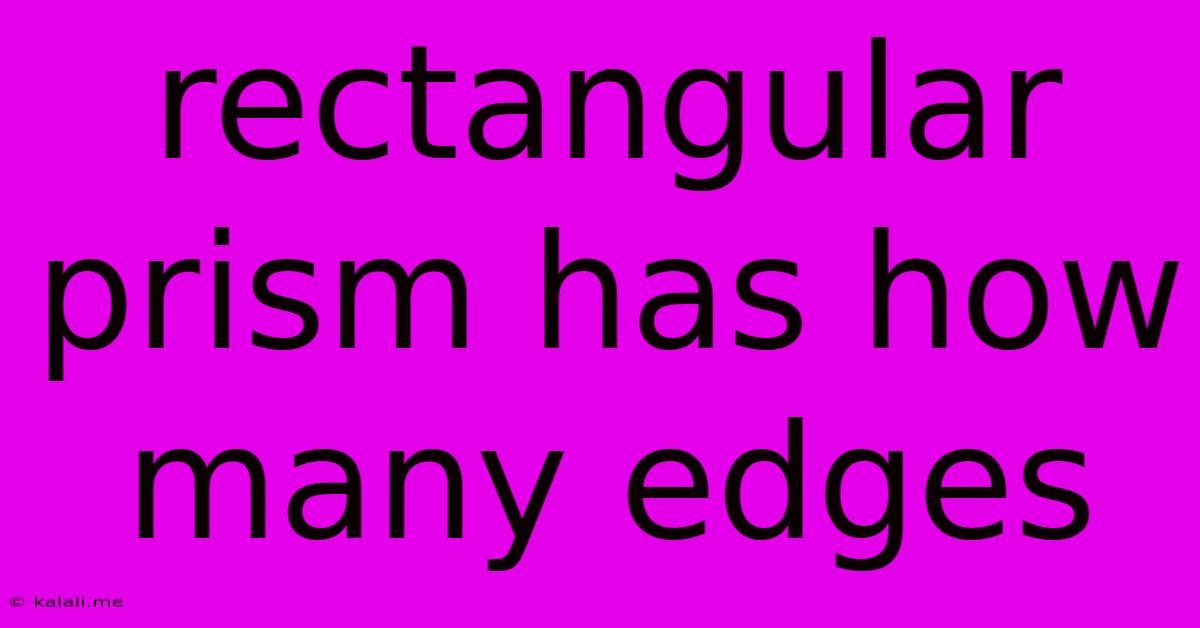Rectangular Prism Has How Many Edges
Kalali
May 10, 2025 · 3 min read

Table of Contents
How Many Edges Does a Rectangular Prism Have? A Comprehensive Guide
A rectangular prism, also known as a cuboid, is a three-dimensional shape with six rectangular faces. Understanding its properties, including the number of edges, is crucial in various fields, from geometry to architecture. This article will delve into the details of a rectangular prism, focusing specifically on determining its number of edges. We'll explore the definition, key features, and finally, answer the main question: how many edges does a rectangular prism have?
What is a Rectangular Prism?
A rectangular prism is a three-dimensional geometric shape characterized by:
- Six rectangular faces: These faces are parallelograms, meaning opposite sides are parallel and equal in length.
- Twelve edges: These are the line segments where two faces meet.
- Eight vertices: These are the points where three edges intersect.
Each face is a rectangle, and opposite faces are congruent (identical in shape and size). Think of a shoebox, a brick, or a die – these are all examples of rectangular prisms. Understanding the relationship between faces, edges, and vertices is key to grasping the prism's geometry.
Counting the Edges of a Rectangular Prism
Now, let's address the central question: how many edges does a rectangular prism possess? To accurately count the edges, we can approach this systematically:
- Top and Bottom Faces: Each of these faces has four edges. That's 4 + 4 = 8 edges.
- Connecting Edges: The four vertical edges connect the top and bottom faces. This adds another 4 edges.
- Total Edges: Adding the edges of the top and bottom faces with the connecting edges, we arrive at a total of 8 + 4 = 12 edges.
Therefore, a rectangular prism has a total of 12 edges.
Understanding the Relationship Between Faces, Edges, and Vertices (Euler's Formula)
The number of faces, edges, and vertices of a polyhedron (a three-dimensional shape with flat faces) are related by Euler's formula:
F + V - E = 2
Where:
- F = Number of faces
- V = Number of vertices
- E = Number of edges
For a rectangular prism:
- F = 6
- V = 8
- E = 12
Plugging these values into Euler's formula: 6 + 8 - 12 = 2. The equation holds true, confirming our count of 12 edges.
Applications and Significance
Understanding the properties of a rectangular prism, including its edge count, is essential in various fields:
- Engineering: Calculations involving volume, surface area, and structural integrity often rely on knowing the dimensions and properties of rectangular prisms.
- Architecture: Designing buildings and structures frequently involves working with rectangular prisms as foundational elements.
- Packaging and Logistics: Optimizing packaging and shipping often involves understanding how to efficiently arrange and stack rectangular prisms.
- Mathematics: Rectangular prisms serve as foundational shapes for exploring more complex geometric concepts.
In conclusion, a rectangular prism definitively has 12 edges. This knowledge is fundamental to understanding spatial reasoning and crucial in various practical applications. By systematically counting the edges and understanding the relationship between faces, edges, and vertices via Euler's formula, we can confidently assert that the answer remains consistently twelve.
Latest Posts
Latest Posts
-
How Many Months Is A Hundred Days
Jul 18, 2025
-
Mother And I Or Mother And Me
Jul 18, 2025
-
How Many Oz In One Water Bottle
Jul 18, 2025
-
How Many Dimes In A 5 Roll
Jul 18, 2025
-
How Do You Say Basil In Spanish
Jul 18, 2025
Related Post
Thank you for visiting our website which covers about Rectangular Prism Has How Many Edges . We hope the information provided has been useful to you. Feel free to contact us if you have any questions or need further assistance. See you next time and don't miss to bookmark.